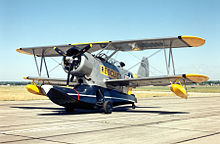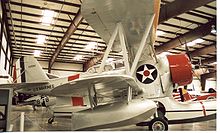- Grumman J2F Duck
-
J2F Duck Grumman J2F-5 Duck in early 1942 Role Utility amphibian Manufacturer Grumman/
Columbia Aircraft CorpFirst flight 1936 Introduction 1936 Primary users United States Navy
United States Army Air Forces
United States Coast Guard
United States Marine Corps
Argentine NavyNumber built 584 Developed from Grumman JF Duck The Grumman J2F Duck (company designation G-15) was an American single-engine amphibious biplane. It was used by each major branch of the U.S. armed forces from the mid-1930s until just after World War II, primarily for utility and air-sea rescue duties. It was also used by the Argentine Navy, who took delivery of their first Duck in 1937. After the war, J2F Ducks saw service with independent civilian operators, as well as the armed forces of Colombia and Mexico.
The J2F was an improved version of the earlier JF Duck, with its main difference being a longer float.[1]
Contents
Development
The J2F-1 Duck first flew on 2 April 1936, powered by a 750 hp (559 kW) Wright R-1820 Cyclone, and was delivered to the U.S. Navy on the same day. The J2F-2 had a Wright Cyclone engine which was boosted to 790 hp (589 kW). Twenty J2F-3 variants were built in 1939 for use by the Navy as executive transports with plush interiors. Due to pressure of work following the United States entry into the war in 1941, production of the J2F Duck was transferred to the Columbia Aircraft Corp of New York. They produced 330 aircraft for the Navy and U.S. Coast Guard.[2]
Several surplus Navy Ducks were converted for use by the United States Air Force in the air-sea rescue role as the OA-12 in 1948.
Design
The J2F was an equal-span single-bay biplane with a large monocoque central float which also housed the retractable main landing gear. The aircraft had strut-mounted stabilizer floats beneath each lower wing. A crew of two or three were carried in tandem cockpits, forward for the pilot and rear for an observer with room for a radio operator if required. It had a cabin in the fuselage for two passengers or a stretcher.
The Duck's main pontoon was blended into the fuselage, making it almost a flying boat despite its similarity to a conventional landplane which has been float-equipped. This configuration was shared with the earlier Loening OL, Grumman having acquired the rights to Loening's hull, float and undercarriage designs.[3] Like the F4F Wildcat, its narrow-tracked landing gear was hand-cranked.
Operational history
The J2F was used by the U.S. Navy, Marines, Army Air Forces and Coast Guard. Apart from general utility and light transport duties, its missions included mapping, scouting/observation, anti-submarine patrol, air-sea rescue work, photographic surveys and reconnaissance, and target tug.
A J2F of the utility squadron of US Patrol Wing 10 was destroyed at Mariveles Bay, Philipines, by a Japanese air raid on 5 January 1942.[4]
Variants
 OA-12 in USAF markings (this aircraft was a J2F-6 painted to resemble an OA-12A, at the USAF Museum in Dayton, Ohio).
OA-12 in USAF markings (this aircraft was a J2F-6 painted to resemble an OA-12A, at the USAF Museum in Dayton, Ohio).
- J2F-1
- Initial production version with 750 hp R-1820-20 engines, 29 built.
- J2F-2
- United States Marine Corps version with nose and dorsal guns and underwing bomb racks, 21 built.
- J2F-2A
- As J2F-2 with minor changes for use in the United States Virgin Islands, nine built.
- J2F-3
- J2F-2 but powered by a 850 hp R-1820-26 engine, 20 built.
- J2F-4
- J2F-2 but powered by a 850 hp R-1820-30 engine and fitted with target towing equipment, 32 built.
- J2F-5
- J2F-2 but powered by a 1,050 hp R-1820-54 engine, 144 built.
- J2F-6
- Columbia Aircraft built version of the J2F-5 with a 1,050 hp R-1820-64 engine in a long-chord cowling, fitted with underwing bomb racks and provision for target towing gear; 330 built.
- OA-12
- Air-sea rescue conversion for the United States Army Air Forces (and later United States Air Force, OA-12A).
Operators
- Argentine Naval Aviation [5]
- Mexican Navy operated a small number of ex-U.S. Navy J2F-6s post-World War II.[7]
 Columbia-built J2F-6 Duck in U.S. Marine Corps markings displayed at Planes of Fame Museum in Valle, Arizona, October 2005.
Columbia-built J2F-6 Duck in U.S. Marine Corps markings displayed at Planes of Fame Museum in Valle, Arizona, October 2005.
- United States Army Air Forces
- United States Coast Guard
- United States Marine Corps
- United States Navy
- Peruvian Navy ex-USN.
Survivors
The United States Coast Guard is currently working with North South Polar Recoveries to recover a J2F-4 Duck downed in a storm on a Greenland glacier. Three Coast Guard airmen were lost and presumed still entombed at the site. The Duck is presumed to be under more than 130 ft (40 m) of ice. [8]
Noted aircraft collector Kermit Weeks has been the top Duck owner since World War II, owning as many as four. Two of Weeks' J2Fs were traded for other aircraft, one is under restoration, and the fourth is flyable and on display at Fantasy of Flight in Polk City, Florida.
Specifications (J2F-6)
Data from Jane’s Fighting Aircraft of World War II[9]
General characteristics
- Crew: two (pilot and observer)
- Capacity: two rescued airmen
- Length: 34 ft 0 in (10.37 m)
- Wingspan: 39 ft 0 in (11.9 m)
- Height: 13 ft 11 in (4.25 m)
- Wing area: 409 ft² (38 m²)
- Empty weight: 5,480 lb (2,485 kg)
- Loaded weight: 7,700 lb (3,496 kg)
- Powerplant: 1 × Wright R-1820-54 nine-cylinder radial engine, 900 hp (670 kW)
Performance
- Maximum speed: 190 mph (304 km/h)
- Cruise speed: 155 mph (248 km/h)
- Stall speed: 70 mph (112 km/h)
- Range: 780 mi (1,255 km)
- Service ceiling: 20,000 ft (6,100 m)
- Rate of climb: ft/min (m/s)
Armament
- 1 × Browning .30 cal machine gun (7.62 mm) on flexible mount in rear cockpit
- 650 lb (295 kg) of bombs or depth charges
Popular culture
- A J2F Duck was used in the 1971 film Murphy's War, which includes a spectacular three-minute rough water takeoff scene along with numerous flying and aerobatic sequences. The actual airplane used in this film is on display at the National Museum of the United States Air Force near Dayton, Ohio; although it has been restored and painted to represent a rescue OA-12.
- A Grumman Duck was also seen in several episodes of the 1970s TV series Baa Baa Black Sheep, (aka Black Sheep Squadron) based on the legendary exploits of Marine fighter squadron VMF-214.
See also
- Related development
- Grumman JF Duck
- Aircraft of comparable role, configuration and era
References
- Notes
- ^ Allen 1983, p. 49.
- ^ Jordan, Corey C. "Grumman's Ascendency: Chapter Two." Planes and Pilots Of World War Two, 2000. Retrieved: 22 July 2011.
- ^ Allen 1983, p. 47.
- ^ Alsleben, Allan. "US Patrol Wing 10 in the Dutch East Indies, 1942." Forgotten Campaign: The Dutch East Indies Campaign 1941-1942, 2000. Retrieved: 22 July 2011.
- ^ Nuñez Padin, 2002.
- ^ Allen 1983, p. 77.
- ^ Allen 1983, p. 52.
- ^ Mungier, Monique. "Race to Find Aviators Entombed in Greenland Glacier." The New York Times, 20 September 2010. Retrieved: 24 September 2010.
- ^ Bridgeman 1946, pp. 235–236.
- Bibliography
- Allen, Francis J. "A Duck Without Feathers". Air Enthusiast. Issue 23, December 1983—March 1984, pp. 46–55, 77–78. Bromley, Kent UK: Pilot Press, 1983.
- Bridgeman, Leonard. “ The Grumman Duck .” Jane's Fighting Aircraft of World War II. London: Studio, 1946. ISBN 1-85170-493-0.
- Hosek, Timothy. Grumman JF Duck - Mini in Action 7. Carrollton, Texas: Squadron/Signal Publications Inc., 1996. ISBN 0-89747-366-3.
- Jarski, Adam. Grumman JF/J2F Duck (Monografie Lotnicze 98) (in Polish with English captions). Gdańsk, Poland: AJ-Press, 2007. ISBN 83-7237-169-0.
- Nuñez Padin, Jorge Félix. Grumman G.15, G.20 & J2F Duck (Serie Aeronaval Nro. 15) (in Spanish). Buenos Aires, Argentina: Museo de Aviación Naval, Instituto Naval, 2002.
External links
Grumman and Northrop Grumman aircraft Manufacturer
designationsG-1 (floats only) · G-2 (floats only) · G-3 · G-4 · G-5 · G-6 · G-7 · G-8 · G-9 · G-10 · G-11 · G-12 · G-13 · G-14 · G-15 · G-16 · G-17 · G-18 · G-19 · G-20 · G-21 · G-22 · G-23 · G-24 · G-25 · G-26 · G-27 · G-29 · G-30 · G-31 · G-32 · G-33 · G-34 · G-35 · G-36 · G-37 · G-38 · G-39 · G-40 · G-41 · G-42 · G-43 · G-44 · G-45 · G-46 · G-47 · G-48 · G-49 · G-50 · G-51 · G-52 · G-53 · G-54 · G-55 · G-56 · G-57 · G-58 · G-59 · G-60 · G-61 · G-62 · G-63 · G-64 · G-65 · G-66 · G-67 · G-68 · G-69 · G-70 · G-71 · G-72 · G-73 · G-74 · G-75 · G-76 · G-77 · G-78 · G-79 · G-80 · G-81 · G-82 · G-83 · G-84 · G-85 · G-86 · G-87 · G-88 · G-89 · G-90 · G-91 · G-92 · G-93 · G-94 · G-96 · G-97 · G-98 · G-98J · G-99 · G-100 · G-101 · G-102 · G-103 · G-104 · G-105 · G-106 · G-107 · G-108 · G-109 · G-110 · G-111 · G-112 · G-113 · G-114 · G-115 · G-116 · G-117 · G-118 · G-119 · G-120 · G-121 · G-122 · G-123 · G-124 · G-125 · G-126 · G-127 · G-128 · G-134 · G-159 · G-164 · G-191 · G-231 · G-234 · G-251 · G-262 · G-303 · G-426 · G-712 · G-1128 · G-1159
By role Piston fightersJet fightersF9F · F9F/F-9 · XF10F · F11F/F-11/F11F-1F · G-118 · F-111B · F-14
Attack/PatrolRecon/ScoutsUtility/TransportsCivil aircraftMallard · Ag Cat · Kitten · Tadpole · Gulfstream I · Gulfstream II
OthersApollo Lunar Module · EF-111 · X-29 · Q-8 · X-47A · X-47B
By name Ag Cat · Albatross · Avenger · Bearcat · Cougar · Duck · Fifi · Goose · Greyhound · Guardian · Gulfhawk III · Gulfstream I · Gulfstream II · Hawkeye · Hellcat · Intruder · Jaguar · Kitten · Mallard · Mohawk · Panther · Pegasus · Prowler · Skyrocket · Super Tiger · Tadpole · Tiger · Tigercat · Tomcat · Tracer · Tracker · Trader · Wildcat · Widgeon
USAAC/USAAF observation aircraft Observation O-1 • O-2 • XO-3 • XO-4 • O-5 • O-6 • O-7 • O-8 • O-9 • XO-10 • O-11 • O-12 • O-14 • XO-14 • XO-15 • XO-16 • O-17 • XO-18 • O-19 • YO-20 • XO-21 • O-22 • YO-23 • O-24 • O-25 • Y1O-26 • Y1O-27 • O-28 • O-29 • O-30 • O-31 • O-32 • Y1O-33 • O-34 • O-35 • XO-36 • O-37 • O-38 • O-39 • O-40 • Y1O-41 • O-42 • O-43 • XO-44 • O-45 • O-46 • O-47 • XO-48 • O-49 • YO-50 • YO-51 • O-52 • O-53 • YO-54 • YO-55 • O-56 • O-57 • O-58 • O-59 • O-60 • XO-61 • O-62 • XO-63
Observation Amphibian USN/USMC utility aircraft designations 1935–1955 Utility Stearman-HammondJHJK · J2K
JLLockheedJOFairchildFordJW · J2W
Utility transport SikorskyLists relating to aviation General Aircraft (manufacturers) · Aircraft engines (manufacturers) · Airlines (defunct) · Airports · Civil authorities · Museums · Registration prefixes · Rotorcraft (manufacturers) · TimelineMilitary Accidents/incidents Records Categories:- United States military utility aircraft 1930–1939
- United States Coast Guard Aviation
- Grumman aircraft
- Amphibious aircraft
Wikimedia Foundation. 2010.


